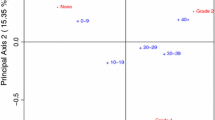Abstract
A combinatorial data analysis strategy is reviewed that is designed to compare two arbitrary measures of proximity defined between the objects from some set. Based on a particular cross-product definition of correspondence between these two numerically specified notions of proximity (typically represented in the form of matrices), extensions are then pursued to indices of partial association that relate the observed pattern of correspondence between the first two proximity measures to a third. The attendant issues of index normalization and significance testing are discussed; the latter is approached through a simple randomization model implemented either through a Monte Carlo procedure or distributional approximations based on the first three moments. Applications of the original comparison strategy and its extensions to partial association may be developed for a variety of methodological and substantive tasks. Besides rank correlation, we emphasize the topics of spatial autocorrelation for one variable and spatial association between two and mention the connection to the usual randomization approach for one-way analysis-of-variance.
Similar content being viewed by others
References
Campbell, D. T., Kruskal, W. H., & Wallace, W. P. (1966). Seating aggregation as an index of attitude.Sociometry, 29, 1–15.
Cliff, A. D., & Ord, J. K. (1981).Spatial processes: Models and applications. London: Pion.
Constanzo, C. M., Hubert, L. J., & Golledge, R. G. (1983). A higher moment for spatial statistics.Geographical Analysis, 15, 347–351.
Daniels, H. E. (1944). The relation between measures of correlation in the universe of sample permutations.Biometrika, 33, 129–135.
Davis, J. A. (1971).Elementary survey analysis. Englewood Cliffs, NJ: Prentice-Hall.
Dietz, E. J. (1983). Permutation tests for association between two distance matrices.Systematic Zoology, 32, 21–26.
Douglas, M. E., & Endler, J. A. (1982). Quantitative matrix comparisons in ecological and evolutionary investigations.Journal of Theoretical Biology, 99, 777–795.
Freeman, L. C. (1978). Segregation in social networks.Sociological Methods and Research, 6, 411–429.
Glick, B. J. (1979). Tests for space-time clustering used in cancer research.Geographical Analysis, 11, 202–208.
Hubert, L. J. (1983). Inference procedures for the evaluation and comparison of proximity matrices. In J. Felsenstein (Ed.),Numerical taxonomy. New York: Springer-Verlag.
Hubert, L. J., Golledge, R. G., & Costanzo, C. M. (1981). Generalized procedures for evaluating spatial auto-correlation.Geographical Analysis, 13, 224–233.
Hubert, L. J., Golledge, R. G., & Costanzo, C. M. (1982). Analysis of variance procedures based on a proximity measure between subjects.Psychological Bulletin, 91, 424–430.
Hubert, L. J., Golledge, R. G., Costanzo, C. M., & Gale, N. (1985). Measuring association between spatially defined variables: An alternative procedure.Geographical Analysis, 17, 36–46.
Hubert, L. J., Golledge, R. G., Costanzo, C. M., Gale, N., & Halperin, W. C. (1984). Nonparametric tests for directional data. In G. Bahrenberg, M. Fischer, & P. Nijkamp (Eds.),Recent developments in spatial analysis: Methodology, measurement, models (pp. 171–190). Aldershot, UK: Gower.
Hubert, L. J., & Schultz, J. V. (1976). Quadratic assignment as a general data analysis strategy.British Journal of Mathematical and Statistical Psychology, 29, 190–241.
Klauber, M. R. (1975). Space-time clustering for more than two samples.Biometrics, 31, 719–726.
Mantel, N. (1967). The detection of disease clustering and a generalized regression approach.Cancer Research, 27, 209–220.
Mielke, P. W. (1979). On asymptotic non-normality of null distributions of MRPP statistics.Communications in Statistics—Theory and Methods, A8, 1541–1550. (errata:A10, 1981, p. 1795 andA11, 1982, p. 847).
Mielke, P. W., Berry, K. J., & Brier, G. W. (1981). Application of multiresponse permutation procedures for examining seasonal changes in monthly mean sea-level pressure patterns.Monthly Weather Review, 109, 120–126.
Pike, M. C., & Smith, P. G. (1974). A case-control approach to examine diseases for evidence of contagion, including diseases with long latent periods.Biometrics, 30, 263–279.
Puri, M. L., & Sen, P. K. (1971).Nonparametric methods in multivariate analysis. New York: Wiley.
Quade, D. (1974). Nonparametric partial correlation. In H. M. Blalock, Jr. (Ed.),Measurement in the social sciences: Theories and strategies (pp. 369–398). Chicago: Aldine.
Raveh, A. (in press). On measures of monotone association.American Statistician.
Reynolds, H. T. (1977).The analysis of class classifications. New York: Free Press.
Sokal, R. R. (1979). Testing statistical significance of geographical variation patterns.Systematic Zoology, 28, 227–232.
Somers, R. H. (1959). The rank analogue of product-moment partial correlation and regression, with application to manifold, ordered contingency tables.Biometrika, 46, 241–246.
Winsborough, H. H., Quarantelli, E. L., & Yutzy, D. (1963). The similarity of connected observations.American Sociological Review, 28, 977–983.
Author information
Authors and Affiliations
Rights and permissions
About this article
Cite this article
Hubert, L.J. Combinatorial data analysis: Association and partial association. Psychometrika 50, 449–467 (1985). https://doi.org/10.1007/BF02296263
Received:
Revised:
Issue Date:
DOI: https://doi.org/10.1007/BF02296263




